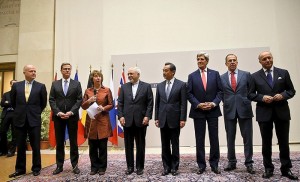 The first phase of the U.S.-led international effort to address the Iranian nuclear program ended this week, but the second has just begun.
The first phase of the U.S.-led international effort to address the Iranian nuclear program ended this week, but the second has just begun.On Monday, Iran began to implement an interim accord signed in November with the U.S. and its partners in the P5+1 (the permanent five members of the United Nations Security Council plus Germany). Known as the�Joint Plan of Action�(JPA), the agreement offers Iran limited and reversible sanctions relief in exchange for halting key elements of its nuclear program, reducing its stockpile of enriched uranium (thereby lengthening the time in which it could conceivably dash toward a nuclear weapon), and dramatically increasing access to its nuclear facilities for inspectors from the International Atomic Energy Agency (IAEA).
The implementation of the JPA on January 20 is an important marker in the negotiations process, but it's important to recognize that what it marks is merely the end of the beginning of what will likely be a painstaking and complicated process. Iran still needs to address all of the international community's concerns over the weaponization of its nuclear works (something Iran has continued to deny) before the formidable economic sanctions constructed around the country can be completely lifted.
But let's also take a step back for a moment and acknowledge how far the U.S. and Iran have come in the space of a few short months.
A year ago, interaction between the U.S. and Iran amounted to little more than each side's negotiators talking past each other. But since the June 2013 election of Hassan Rouhani, who ran on a platform of improving relations with the international community and easing Iran's economic difficulties (which are partly the result of sanctions, and partly the result of Iran's own economic mismanagement), the chances for ending the U.S.-Iran cold war seem better than ever. Conciliatory messages from the Rouhani administration (aided by a�secret U.S. outreach effortthat predated Rouhani's election) culminated in the�first-ever phone call�between a President of the United States and a President of the Islamic Republic of Iran.
After decades of tension, mistrust, and cold war that occasionally threatened to turn hot, the U.S. and Iran seem to finally have established some measure of trust, enabled by the fact that both countries now have presidents who see diplomacy and negotiations as the most effective way to advance their country's security. And, significantly, both presidents have the support of their own populations in this regard.
Rouhani was the surprise victor in Iran's presidential election. The smart money at the time was on Saeed Jalili, a hardliner who was�seen as the favorite�of Iran's Supreme Leader Ayatollah Khamenei, and who promised an even more defiant stance on Iran's nuclear program. In electing Rouhani, Iranian voters sent a strong signal that they desired an easing of tensions with the West, not an escalation � a fact not lost on Khamenei, who acquiesced to Rouhani's victory rather than tip the scales in Jalili's favor, as many believe he did for his previous favorite, Mahmoud Ahmadinejad. Importantly, Khamenei has made clear his support for Rouhani's negotiations effort, and warned Rouhani's hardline critics to give him time to reach an agreement.
In the U.S., polls have repeatedly shown that voters are exhausted of the large-scale military interventions of the previous decade, and far more supportive of efforts to deal with global challenges through diplomacy, rather than military force. On the Iran question specifically, a look at various polls conducted over the past several months show a�strong public consensus in favor�of the deal that was struck in November.
At the same time, both Obama and Rouhani have to contend with considerable criticisms from more hardline elements in their own governments, who remain deeply skeptical that anything good can be achieved through negotiations with the enemy. In Iran, one critic at the hardline newspaper�Kayhan�attacked the JPA, insisting that Iranian Foreign Minister Mohammad Javad Zarif "did not tell the truth" when he claimed that the agreement had secured Iran's nuclear rights.
Obama's critics have been similarly aggressive. On Wednesday, Illinois Republican Senator Mark Kirk�tweetedout a chart entitled "The White House's Iranian appeasement schedule," showing the dates on which Iran would be allowed access to portions of its own frozen assets under the JPA. (For some reason, Kirk's chart neglected to include the benchmarks that Iran would have to meet to receive those payments, like reducing its stockpile of enriched uranium and providing increased access to IAEA inspectors.) Along with New Jersey Democratic Senator Robert Menendez, Kirk has pushed a new Iran sanctions bill that many � including a new U.S. intelligence assessment � believe could�undermine negotiations�with Iran. While that effort appears to be�stalled for the moment, it's a sign of the domestic hurdles that Obama faces in selling an eventual comprehensive deal.
Even if such a deal is achieved, there will remain a whole set of tensions between the U.S. and Iran, such as the latter's support for terrorism, it's continued funding of Bashar Assad's slaughter in Syria, and it's hostility toward Israel. But achieving a nuclear agreement marks a step toward addressing those other issues. Clearly, Congress has a role to play in helping shape foreign policy, and making clear the consequences if Iran does not meet its obligations. But at the end of the day, it's Obama's incremental approach to national security � as opposed to grand, transformative gestures like invading Iraq � that has shown results, and will likely characterize US foreign policy for the foreseeable future.
By The Week Magazine�
The Iran Project is not responsible for the content of quoted articles.










